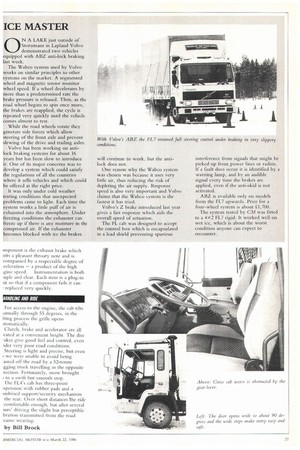ICE MASTER
Page 51

If you've noticed an error in this article please click here to report it so we can fix it.
0 N A LAKE just outside of Storumans in Lapland Volvo demonstrated EWO vehicles equipped with ABZ anti-lock braking last week.
The Wabco system used by Volvo works on similar principles to other systems on the market. A segmented wheel and magnetic sensor monitor wheel speed. If a wheel decelerates by more than a predetermined rate the brake pressure is released. Then, as the road wheel begins to spin once more, the brakes are reapplied, the cycle is repeated very quickly until the vehicle conies almost to rest.
While the road wheels rotate they generate side forces which allow steering of the front axle and prevent stewing of the drive and trailing axles.
Volvo has been working on antilock braking systems for about 16 years but has been slow to introduce it. One of its major concerns was to develop a system which could satisfy the regulations of all the countries Where it sells vehicles and which could be offered at the right price.
It was only under cold weather testing conditions that unexpected problems came to light. Each time the system works a little puff of air is exhausted into the atmosphere. Under freezing conditions the exhauster can freeze up if there is any moisture in the compressed air. lithe exhauster becomes blocked with ice the brakes
will continue to work, but the antilock does not.
One reason why the Wabco system was chosen was because it uses very little air, thus reducing the risk of depleting the air supply. Response speed is also very important and Volvo claims that the \Vatic° system is the fastest it has tried.
Volvo's Z brake introduced last year gives a fast response which aids the overall speed of actuation, The FL cab was designed to accept the control box which is encapsulated in a lead shield preventing spurious interference from signals that might be picked up from power lines or radios. If a fault does occur it is identified by a warning lamp, and by an audible signal every time the brakes are applied, even if the anti-skid is not activated.
ABZ is available Only on -models Irons the FL7 upwards. Price for a four-wheel system is about 1:1,700.
The system tested by CM was fitted to a 4x2 FL7 rigid. It worked well on wet ice, which is about the worst condition anyone can expect to encounter.






















































































